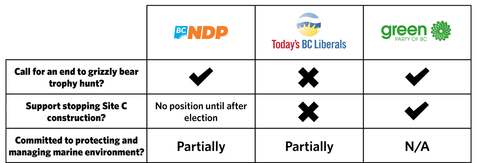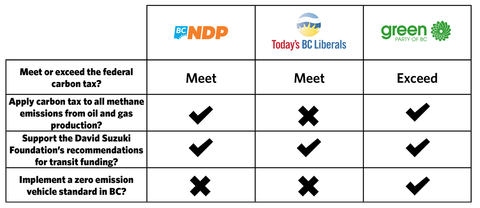David Suzuki's Blog, page 11
May 1, 2017
How Queen's University powered up with sunshine and rainwater
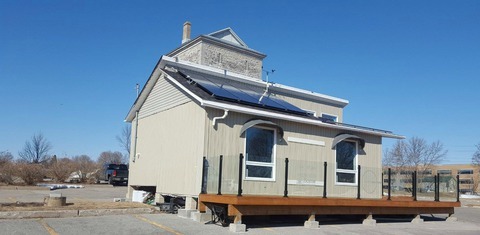
Credit: Katie Yang
In the new age of anxiety -- which we seem to be entering -- institutions of higher education can be outposts of optimism, oases that push back against doomsday scenarios and help us face the future with a measure of hopefulness. Such is the case with a new renewable energy initiative at Queen's University in Kingston, Ontario.
The school has nearly completed the Queen's Solar Education Centre, a project of its Solar Design Team, a gifted crew of engineering, business and marketing students who got their start creating futuristic solar-powered automobiles. In 2000, they set a Guinness world record for the longest "journey in a solar vehicle." By 2008, they had shifted to designing solar-powered homes and began work on the Solar Education Centre in 2014.
John Gao, the design team's marketing manager, tells me the centre -- which resembles a small suburban home complete with shrubs and flower boxes out front -- is "fully autonomous". It doesn't draw its electricity from the grid nor its water from the municipality. Instead, it provides water for drinking and showering by collecting rain, which it triple filters using UV lighting powered with solar panels. The latter also provide 220 watts of direct current for the refrigerator. Electric radiant-floor-heating keeps occupants warm in winter, without the dust created by forced-air systems. Composting toilets handle human waste. ("They don't stink!" says business manager Katie Yang.)

As its name suggests, the Queen's Solar Education Centre is a hub for education and research. Its staff regularly bring in school-age children for workshops on green technology and, in July and August, offer tours for summer-camp kids. Walking lightly on the planet, they learn, is entirely practical. Garrett Mallery, the design team's director, tells me, "It's eye-opening for them. They see that sustainable living is realistic; it's not just a dream or in the future. It's now." The students enjoy themselves at the centre, finding ways to connect renewable energy to their own experience. One youthful visitor asked, "If you take all the mini solar things in calculators and put them on your roof, will it work like a solar panel?" The centre calls forth young people's ingenuity and showcases their desire, even at an early age, to generate environmental solutions.
It also provides a laboratory for groups of masters and doctoral candidates who want to test theories about solar-based heating and cooling. Students Cameron, Elias, Kaldwell and Shen -- under the supervision of associate professor Stephen Harrison -- noted that roof-mounted photovoltaic panels (whose main purpose is electricity production) offer an attractive side benefit: they raise the temperature of air caught beneath them. The young scientists found a way to capture this air and use it to warm the building. Their exciting insight, which the centre helped them explore, is the realization that PV technology can serve a dual purpose, creating both power and heat.
The design team's final goal is widespread behaviour change. Mallery gives the example of plumbing: "Almost everyone in Canada uses clean water for toilets. But that's archaic. They should use grey water to reduce consumption -- which is especially important given that climate change means more water shortages." If an overhaul of this magnitude feels daunting, the team suggests homeowners begin small. "There are lots of little things you can do in your house," Mallery explains. "For example, sealing your windows and using LED lights. And with the drop in solar prices, even putting up PV panels is now relatively easy."
Hey! Want more DSF? Join David Suzuki on Facebook

April 30, 2017
Meet Nikki, your new "reigning" Queen of Green

Nikki will lead you on a year of inspiration! (Credit: Breanna Carey)
Welcome Nikki Sanchez, the reigning Queen of Green during Lindsay Coulter's one-year maternity leave! Here's Lindsay's interview with Nikki, so you can get to know her:
Where's your favourite place in nature?
What comes to mind is the ancient Ahousaht Wild Side heritage trail on Flores Island, off the west coast of Vancouver Island. It covers 22 kilometres of old-growth temperate rainforest and white sand beaches. I was privileged to learn about the many sacred and food harvesting sites along the trail from Elder Stanley Sam. Stanley passed away last summer and now every time I return to the trail I feel his joyful spirit dwelling there. It was a place he loved dearly. I'm so grateful to him for sharing that love of place with me.
What's the best "green living" advice you ever received?
My mentor, Qaamina Sam, taught me about the Nuu-chah-nulth worldview encompassed in the saying "hishuk'ish tsawalk" meaning "everything is one and all is interconnected." I carry that concept into everything I do. I exist in relationship to all other things and must consider the ways in which my thoughts, words and actions affect others and the landscape.
Do you have a favourite DIY recipe?
Working and living in the coastal temperate rainforest means using wild plants. Try a face mask using the strands of fresh bull kelp (Nereocystis luetkeana) and the inner "goo" of bladderwrack (Fucus vesiculosus). It also makes a great swamp monster costume!
How did you celebrate Earth Day 2017?
I completed the cross-country running leg of the Snow to Surf multicourse wilderness race on Mount Washington, Vancouver Island. I was on a team with eight friends to ski, snowshoe, mountain bike, canoe and kayak.
What most excites you about serving the Queen of Green audience?
I believe building strong communities of people who share a common love for Earth and want to create a sustainable future is one of the most important endeavors of our time. I feel incredibly privileged and look forward to learning from and with you.
Can you share a wildlife encounter story?
While sea kayak guiding I arrived early in a remote location to set up the boats. I desperately needed to pee, walked into the forest and the moment I found a suitable spot, heard footsteps. It was a large female wolf! We stared at each other, then she started to walk towards me slowly. I encouraged her not to get too close. She sauntered down the beach, and to my delight, turned around every few steps and looked back at me.
Name three things on your bucket list:
Dance underneath the aurora borealis
Swim with belugas
Sing in public
What are you reading?
All Over Creation by Ruth Ozeki, a novel exploring the moral and environmental impacts of bioengineering. I've also started Purity by Jonathan Franzen. He does an incredible job of illuminating the complexity of human experience and the ways in which we are all interconnected.
When you're not the Queen of Green, what will you be doing?
I'm a PhD student in environmental studies and Indigenous governance at the University of Victoria. I spend a lot of time in the library. I'm also a wilderness educator, community organizer and closet poet. On sunny days you'll find me running trails, climbing mountains or kayaking with my dogs Witwalk and Diego.
Thank you for welcoming Nikki. Have a great year!
Sincerely,
Lindsay Coulter, a fellow Queen of Green
Hey! Want more DSF? Join David Suzuki on Facebook

April 28, 2017
Health Canada's glyphosate evaluation flawed, environmental groups charge
Widespread use of world's most extensively sold pesticide continues, despite international concerns about health and ecological risks
OTTAWA - April 28, 2017 -- Health Canada has dismissed credible evidence in its re-evaluation of the world's most extensively sold pesticide, glyphosate, in today's decision to continue its registration in Canada.
Glyphosate is infamous as the active ingredient in Monsanto's herbicide Roundup, and is now used in hundreds of other herbicides manufactured by many of the largest agrichemical companies.
"The widespread use of glyphosate is contaminating the environment and the food we eat," said Louise Hénault-Éthier, science projects manager at the David Suzuki Foundation. "Research shows that glyphosate is persistent and that buffer zones are not necessarily effective in preventing run-off to streams. Furthermore, nearly a third of our food contains glyphosate, according to the Canadian Food Inspection Agency."
The World Health Organization's International Agency for Research on Cancer classifies glyphosate as "probably carcinogenic to humans." Many researchers also consider glyphosate-based herbicides as potential endocrine disruptors.
Glyphosate also has a role in the precipitous decline of monarch butterfly populations. Widespread use of glyphosate has virtually eradicated milkweed in corn- and soy-growing regions of North America. Milkweed is the sole food source for monarch larvae.
"Glyphosate is used in more than 180 pest control products in Canada, combined with other chemicals such as surfactants and sometimes other pesticides, yet Health Canada fails to consider the cumulative effects," said Elaine MacDonald, program director of Healthy Communities at Ecojustice.
"We are concerned with the changes to the labelling restrictions on glyphosate announced today," said Annie Berube, director of government relations at Équiterre. "Health Canada recognizes there are risks to using glyphosate that warrant those labelling changes, but the burden cannot be on users to manage the risks of using glyphosate by following instructions on labels. It is incumbent upon Health Canada to protect Canadians' health and our environment, and pesticide labels alone are insufficient."
The European Commission has recommended restricting certain uses of glyphosate and is expected to revisit its approval of the pesticide later this year.
Équiterre, Ecojustice and the David Suzuki Foundation are calling on Health Canada to reconsider its evaluation, and restrict the use of glyphosate based on evidence of harm. The groups are also urging the federal government to recognize the monarch butterfly as an endangered species under the federal Species at Risk Act, in accordance with the recent assessment of the Committee on the Status of Endangered Wildlife in Canada (COSEWIC). They are also calling for restrictions on glyphosate use in monarch habitats.
- 30 -
For more information or to arrange an interview, please contact:
Manon Dubois
David Suzuki Foundation
mdubois@davidsuzuki.org
514-679-0821
Dale Roberston
Équiterre
drobertson@equiterre.org
514-605-2000
Dr. Elaine MacDonald
Ecojustice
emacdonald@ecojustice.ca
416-368-7533 ext. 527
Hey! Want more DSF? Join David Suzuki on Facebook

April 27, 2017
Ontario budget emphasizes crucial investment in transit, electric vehicles
TORONTO -- The David Suzuki Foundation applauds the Ontario government's plan to spend $56 billion on public transit infrastructure over the next 10 years, as announced today in the Ontario budget. The amount is more than twice what the province will spend on highways.
"This prioritization of transit over road-building is welcome because transportation is the largest source of greenhouse gases in the province," said Foundation policy analyst Gideon Forman. "Helping Ontarians leave the car at home and take light rail or a bike is crucial."
The province is also earmarking about $90 million this year to promote electric vehicle use. That money will come from the sale of allowances through Ontario's cap and trade program.
"We recognize not everyone can take transit, walk or cycle. Some folks will need a car," Forman said. "But if we're going to tackle climate change, we have to ensure that car is electric."
Other 2017-18 projects funded through cap and trade revenue will include:
• $200 million to help schools enhance energy efficiency and set up renewable energy systems such as solar panels or geothermal heat pumps
• $85 million to retrofit social housing
• $50 million to improve commuter cycling infrastructure, including cycling lanes and signals
"These investments are exciting because they have a whole range of co-benefits," Forman said. "When you build bike lanes, for example, you improve air quality and also increase people's fitness. When you install solar arrays on schools, you produce both electricity and opportunities for educating students about power generation."
When the government passed cap and trade legislation in 2016, it suggested annual revenue from the system would be about $1.9 billion. Today's budget takes a more cautious approach, suggesting it may only generate $1.4 billion a year.
"This approach calls into question whether the government will be able to bring in a full range of climate change-reduction activities like transit and renewable energy," Forman said.
30
FOR MORE INFORMATION:
Gideon Forman, Climate Change and Transportation Policy Analyst
647-703-5957
Hey! Want more DSF? Join David Suzuki on Facebook

The grisly truth about B.C.'s grizzly trophy hunt
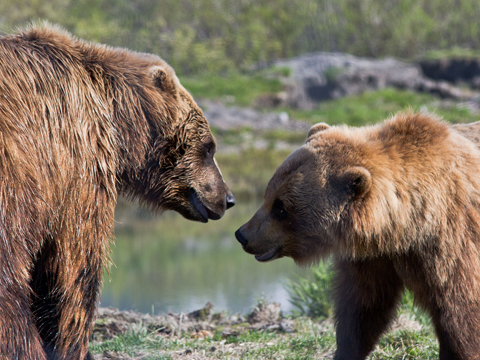
(Credit: Leonemoff via Flickr)
Grizzly bears venturing from dens in search of food this spring will face landscapes dominated by mines, roads, pipelines, clearcuts and ever-expanding towns and cities. As in years past, they'll also face the possibility of painful death at the hands of trophy hunters.
British Columbia's spring bear hunt just opened. Hunters are fanning across the province's mountains, grasslands, forests and coastline, armed with high-powered rifles and the desire to bag a grizzly bear, just to put its head on a wall or its pelt on the floor as a "trophy".
According to B.C. government statistics, they will kill about 300 of these majestic animals by the end of the spring and fall hunts. If this year follows previous patterns, about 30 per cent of the slaughter will be females -- the reproductive engines of grizzly populations.
Many grizzlies will likely be killed within B.C.'s renowned provincial parks and protected areas, where trophy hunting is legal. Government records obtained by the David Suzuki Foundation in 2008 show trophy hunters have shot dozens of grizzly bears in places we would expect wildlife to be protected. We don't know the exact number of bears killed in B.C.'s parks since 2008 because, in contravention of a B.C.'s privacy commissioner's ruling, the government refuses to disclose recent spatial data showing where bears have been killed.
Much of this killing has occurred in northern wilderness parks, such as Height of the Rockies Provincial Park, Spatsizi Plateau Wilderness Park and Tatshenshini-Alsek Wilderness Park. Tatshenshini-Alsek Park forms a massive transboundary conservation zone with federal protected areas in the Yukon (Kluane National Park and Reserve) and Alaska (Glacier Bay National Park and Preserve and Wrangell-St. Elias National Park and Preserve). Trophy hunting is prohibited in most U.S. national parks and all Canadian national parks, but not in B.C.'s provincial parks.
Wild animals don't heed political boundaries. Wide-ranging species like grizzly bears move in and out of neighbouring jurisdictions. If a grizzly bear in Montana wanders a few kilometres north in search of a mate, it goes from being protected by the U.S. Endangered Species Act to being a possible trophy hunter target in B.C.
But now, in response to intense pressure from the trophy hunting industry, the U.S. administration wants to strip grizzly bears of federal protection. President Trump also recently signed into law rules allowing trophy hunters to target grizzly bears around bait stations and from aircraft, and to kill grizzly mothers and their cubs in Alaska's national wildlife refuges, where they've been protected from these unethical hunting practices.
Grizzly bears face an ominous political climate under the Trump administration, along with growing human threats across their North American range, from trophy hunting to habitat destruction, precipitous declines in food sources like salmon and whitebark pine nuts, and climate change impacts.
In parts of Canada, mainly in sparsely populated areas of northern B.C. and the territories, grizzly bear numbers are stable. But in the Interior and southern B.C. and Alberta, grizzlies have been relegated to a ragged patchwork of small, isolated and highly threatened habitats -- a vestige of the forests and grasslands they once dominated. The B.C. government has ended grizzly hunting among highly threatened sub-populations in the Interior and southern parts of the province and, in response to pressure from local First Nations, has promised to do the same in the Great Bear Rainforest. But the slaughter of B.C.'s great bear continues everywhere else.
That this year's spring hunt coincides with a B.C. election could bring hope for grizzlies, possibly catalyzing the first change in government wildlife policy in close to two decades. The May 9 election will give B.C. residents the opportunity to ask candidates if they will end the grizzly hunt if elected. So far, the B.C. NDP and Green Party say they would ban grizzly trophy hunting (but allow grizzly hunting for food), whereas the B.C. Liberals continue to defend and promote the trophy hunt as "well-managed," despite scientific evidence to the contrary.
The fate of B.C.'s grizzlies is too important to be a partisan issue. All politicians should support protection. Rough-and-tumble politics this election season might finally end B.C.'s cruel and unsustainable grizzly bear trophy hunt. It's time to stop this grisly business.
Hey! Want more DSF? Join David Suzuki on Facebook

B.C. election 2017: Where the parties stand on key environmental issues

To help you make your decision May 9, the David Suzuki Foundation compared party positions on environmental issues we care most about to help educate our supporters and the public.
We base our positions on the best available science, our mission to protect the diversity of nature and our vision that, within a generation, Canadians act on the understanding that we are all interconnected and interdependent with nature.
If party positions were not public (e.g., in official platforms, media declarations), we asked parties to provide information. "N/A" (not available) on our cheat sheet means we did not receive a response to our questions from the party.
To be included in our analysis, parties must meet two of these three criteria: Have candidates in at least 90 per cent of ridings; received at least 10 per cent of the popular vote in 2013; have at least one seat in the legislature.
Here's a deeper dive into the B.C. Liberal, NDP and Green party positions. Check back to this blog for updates as they come in.
Biodiversity
Grizzly bear trophy hunt: DSF supports ending the grizzly bear trophy hunt.
The Liberal party will continue the grizzly bear trophy hunt, defending and promoting it as "well-managed" and sustainable. They will work to end hunting in the Great Bear Rainforest only. The B.C. government has ended grizzly hunting among highly threatened sub-populations in the Interior and southern parts of the province.
The NDP and Green parties would ban grizzly trophy hunting, but allow grizzly hunting for food. The NDP is leaving open the possibility for hunts where the grizzly meat is consumed. The Greens would make it a rule that anyone who kills a grizzly bear would have to cart the meat out to their home, to discourage hunts by foreigners.
Site C dam: DSF does not support the continuation of Site C dam construction.
The Liberal party says Site C dam is the only way to reliably provide clean energy to B.C.'s growing population over the next 20 years. They point to jobs, clean affordable power and economic benefits.
The NDP will wait to take a position on Site C until after the election. NDP Leader John Horgan says he would shut down the hydroelectric dam if a B.C. Utilities Commission postelection review supports that decision, but does not yet have enough information to take a formal position.
The Green party says that Site C dam is environmentally, economically and socially reckless and would stop construction.
Protecting and managing marine environment: DSF supports funding and implementing the Marine Planning Partnership marine plans. We do not support increased fossil fuel infrastructure on the coast nor the increased ship traffic and spills that come with an oil and gas focused economic plan.
In August, 2016, the Liberal government signed implementation agreements with 17 coastal First Nations for four Marine Planning Partnership plans for the North Pacific Coast. These have not yet been executed. The Kinder Morgan pipeline project was given the green light to proceed with conditions attached. These include world-leading marine oil spill response and prevention and recovery systems for B.C.'s coastline and ocean, to manage and mitigate the risks and costs of heavy oil pipelines and shipments.
The NDP also supports these marine planning agreements. They would work with First Nations to ask the federal government to include federal jurisdiction areas, including a National Marine Conservation Area within the southern Georgia Strait, within the plans.
Both the NDP and Green parties oppose Kinder Morgan pipeline expansion.
Climate
DSF supports policies that show leadership on carbon taxes; apply the carbon tax to all methane emissions from oil and gas; commit to increasing provincial transit investments to move forward the $8 billion Metro Vancouver transportation plan and bring provincial funding closer to 43 per cent; and implement a zero-emission vehicle standard.
Carbon tax
The Liberal party will extend the freeze on the carbon tax (in place since 2012) to 2021 holding the carbon tax at $30 per tonne. Subject to a fairness review, they plan to match the federal targets for a nationwide carbon tax regime of $40 in 2021 and $50 in 2022. The party commits to hit B.C.'s 2050 emissions reductions target, but not its existing 2020 target.
The NDP would meet the federal targets for a nationwide carbon tax of $40 per tonne, but on an accelerated schedule: $36 in 2020, $43 in 2021 and $50 in 2022.
The Green party plans to increase the carbon tax by $10 each year for four years, beginning January 2018. They will increase the tax to $70 per tonne by 2021 (ahead of Ottawa's schedule). They set an interim target of a 40 per cent reduction to emissions below 2007 levels by 2030.
Carbon tax on all methane emissions from oil and gas
The Liberal party will strengthen reductions to fugitive and vented emissions but not apply the carbon tax to these emissions.
The NDP will expand the provincial carbon tax to include fugitive emissions from oil and gas companies.
The Green party will extend the carbon tax to fugitive and vented emissions starting on January 1, 2018. The initial rate will be $10 per tonne rising to $50 by 2021.
Transit funding
The Liberal party will match $2.2 billion in federal funding for proposed major Metro Vancouver transit expansion projects. They will pay for one-third of the Pattullo Bridge replacement and would require local Metro Vancouver mayors to hold another referendum to raise money for their part of the Broadway Subway and Surrey LRT.
The NDP also committed to match federal funding of $2.2 billion for major transit expansion and support the transportation framework put forward by Metro Vancouver mayors. It also committed to $360 million for new rail cars for existing SkyTrain lines and one-third of the $100 million cost of replacing the Pattullo Bridge.
The Green party's platform does not include details of a funding framework for public transit infrastructure investment, but the party has announced publicly that it would match federal funds for transit in Metro Vancouver.
Zero-emission vehicle standard
The Liberal party has not put forward a zero-emission vehicle standard, but have committed to new passenger vehicles in ZEV Alliance jurisdictions -- where world governments are collaborating to adopt electric vehicles more quickly -- to be emissions-free by 2050.
The NDP has also not put forward a standard, but would adopt a target of 30 per cent new zero-emission light duty vehicle sales by 2030, and add targets for 2020 and 2025.
The Green party will legislate a zero-emission vehicle standard to increase availability of non-emitting vehicles.
Right to a healthy environment in provincial law
Only the Green party has committed to an Environmental Bill of Rights, introduced as legislation in May, 2016.
While the NDP commit to recognizing the right to clean, safe drinking water and updating existing legislation to respect the legal rights of First Nations, they do not include a stand-alone Environmental Bill of Rights in their platform or include the right to a healthy environment in existing legal statues.
Hey! Want more DSF? Join David Suzuki on Facebook

April 26, 2017
Clean up Canada's fracking mess
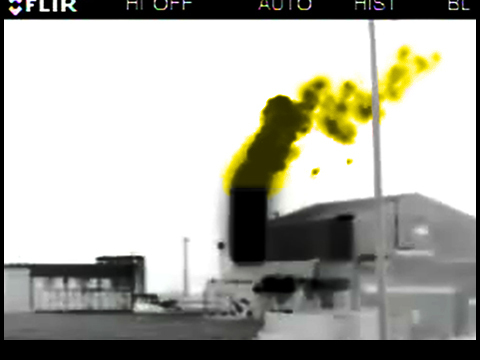
Infrared camera captures potent methane emissions from gas compressor station.
The liquefied natural gas/fracking industry is dumping methane and other harmful chemicals into the air 24 hours a day. Methane is a greenhouse gas that traps 84 times as much heat in the atmosphere as carbon dioxide, accelerating climate change and making this a serious problem.
In northeastern B.C., the David Suzuki Foundation and St. Francis Xavier University recently completed the first ever ground-based measurement of methane emissions in Canada.
Hey! Want more DSF? Join David Suzuki on Facebook

New science reveals unreported methane pollution from B.C.'s oil and gas industry threatens Canada's international climate commitments
VANCOUVER -- Groundbreaking new research estimates fugitive methane emissions from B.C. oil and natural gas operations -- the majority of which use hydraulic fracturing (fracking) -- are at least 2.5 times higher than reported by the B.C. government and may be much higher.
The study, conducted by the David Suzuki Foundation in partnership with St. Francis Xavier University, is the first on-the-ground, comprehensive research on methane emissions in Canada. It highlights the urgent need for the federal government to get methane emissions under control and not delay action as it recently proposed.
"Our peer-reviewed research shows the true magnitude of Canada's methane pollution problem is much bigger than previously estimated by industry and government," Ian Bruce, Foundation director of science and policy said. "Now that we know the extent of the problem, the David Suzuki Foundation is calling on the federal government to take a responsible approach by quickly enacting strong regulations and ensuring industry follows them.
"The federal government has the power to do what's right. It should re-commit to enact strong regulations within months, not years," Bruce said. "The science is clear: Cutting methane pollution is one of the cheapest and most effective ways to address climate change. The technology exists to eliminate industry-released methane."
Over a 20-year period, methane is 84 times more potent than carbon dioxide as a climate pollutant. Leading scientists estimate that methane is responsible for 25 per cent of already observed changes to Earth's climate -- why it's identified as a top climate priority globally.
This research is the first ground-based measurement of methane emissions ever conducted in Canada. Scientists travelled more than 8,000 kilometres using vehicle-mounted gas-detection instruments (a sniffer truck), covering more than 1,600 well pads and facilities in B.C.'s Montney formation. The results are available and undergoing final review in the peer-reviewed scientific journal Atmospheric Chemistry and Physics Discussions.
The research reveals that B.C.'s Montney region alone leaks more than 111,800 tonnes of methane into the air every year. This is the climate pollution equivalent of burning more than 4.5 million tonnes of coal or putting more than two million cars on the road.
Today, Environmental Defence also released a new report showing methane emissions from Alberta's oil and gas industry are significantly higher than previously reported, and pointing to the need for strong federal regulations now to reduce and eliminate these emissions.
"Applied at a national scale, these findings show that fracked gas -- rather than serving as a 'clean' transition fuel -- actually makes it harder for Canada to meet its climate change commitments," Bruce said. "Although our research shows that methane pollution is a big part of the problem, if action is taken now it can also be a big part of the solution."
- 30 -
A media backgrounder summarizing research results and policy recommendations is available here: DSF_fracking_media_backgrounder.pdf
The academic study, Mobile measurement of methane emissions from natural gas developments in Northeastern British Columbia, Canada, is available here:
http://www.atmos-chem-phys-discuss.net/acp-2017-109/
Infrared video clips of methane pollution, and photos of abandoned and leaking wells in British Columbia's Montney region, are available from the David Suzuki Foundation.
For more information, please contact:
Emily Fister
Climate Change & Clean Energy Communications Specialist
David Suzuki Foundation
604-440-5470
Hey! Want more DSF? Join David Suzuki on Facebook

New science reveals climate pollution from B.C.'s oil and gas industry is more than double what government claims
Poorly regulated extraction operations, the majority fracking gas for LNG, make B.C.'s oil and gas industry the largest source of climate pollution in the province.
VANCOUVER -- Methane pollution from the oil and gas industry in British Columbia is now at least 2.5 times higher than stated by the B.C. government, and may be much higher, according to research conducted by the David Suzuki Foundation in partnership with St. Francis Xavier University.
Over a 20-year period, methane is 84 times more potent than carbon dioxide as a climate pollutant. Leading scientists estimate that methane is responsible for 25 per cent of already observed changes to Earth's climate -- why it's identified as a top climate priority globally.
"The finding of our peer-reviewed research is groundbreaking. It shows the true magnitude of B.C.'s methane pollution problem is much bigger than previously reported by industry and government," Ian Bruce, Foundation director of science and policy said. "Now that we know the extent of the problem, the David Suzuki Foundation is calling on B.C.'s next government to make it a priority to get this pollution problem under control and ensure industry is responsible for being part of the solution."
"Our research shows fossil fuel extraction in B.C.'s Montney region alone is intentionally releasing approximately 111,800 tonnes of methane into the air annually," John Werring, Foundation senior science and policy advisor and co-author of the study said. "This is the climate pollution equivalent of burning more than 4.5 million tonnes of coal, or putting more than two million cars on the road. It challenges claims that B.C. LNG is a 'clean' or useful 'transition' fuel."
The Montney region represents more than half (55 per cent) of total gas production in B.C. Approximately half of all well and processing sites in the region intentionally release methane.
Spanning 2015 and 2016, the research is the first ground-based measurement of methane emissions ever conducted in Canada. Scientists travelled more than 8,000 kilometres using vehicle-mounted gas-detection instruments (a sniffer truck), covering more than 1,600 well pads and facilities in the Montney formation. The results are available and undergoing final review in the peer-reviewed scientific journal Atmospheric Chemistry and Physics Discussions.
In 2016, David Suzuki Foundation researchers went back into the field to obtain direct well site and facility measurements, using infrared video cameras and leak-detection equipment. These results corroborate the findings of the vehicle-based surveys, while also identifying abandoned leaking wells that have not been capped and properly reclaimed.
"The good news is cutting methane pollution from the oil and gas sector is one of the cheapest and most effective ways to address climate change," Werring said. "The next B.C. government must establish accountability and proper oversight, so oil and fracked gas activities can eliminate methane pollution by 2030. This should include the use of existing full methane capture technologies, mandatory pollution detection and repair regulations, and the application of the B.C. carbon tax to methane pollution."
- 30 -
A media backgrounder summarizing research results and policy recommendations is available here: DSF_fracking_media_backgrounder.pdf
The academic study, Mobile measurement of methane emissions from natural gas developments in Northeastern British Columbia, Canada, is available here:
http://www.atmos-chem-phys-discuss.net/acp-2017-109/
Infrared video clips of methane pollution, and photos of abandoned and leaking wells in British Columbia's Montney region, are available from the David Suzuki Foundation.
For more information, please contact:
Emily Fister
Climate Change & Clean Energy Communications Specialist
David Suzuki Foundation
604-440-5470
Hey! Want more DSF? Join David Suzuki on Facebook

April 25, 2017
BC Election: Ask your candidates where they stand on the environment
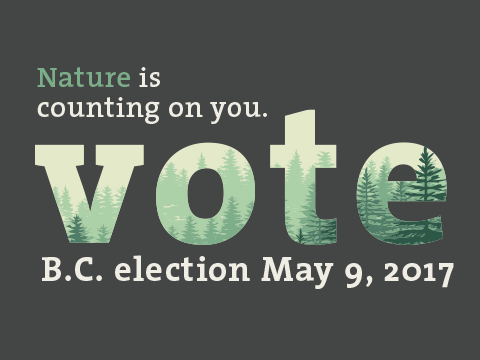
On May 9, British Columbians will choose their next provincial government. With political party announcements coming almost daily, it can be difficult to find what your candidates think about issues that matter to you. We have an easy to use tool to email your local MLA candidates now and keep you informed.
Hey! Want more DSF? Join David Suzuki on Facebook

David Suzuki's Blog
- David Suzuki's profile
- 247 followers


